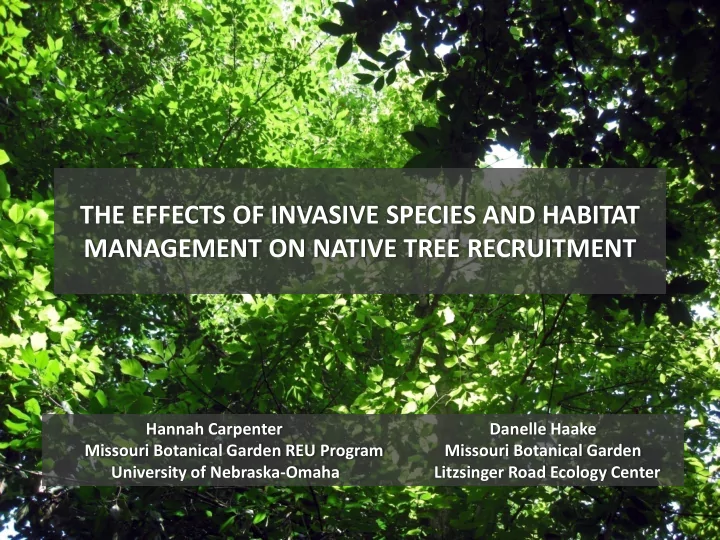

THE EFFECTS OF INVASIVE SPECIES AND HABITAT MANAGEMENT ON NATIVE TREE RECRUITMENT Hannah Carpenter Danelle Haake Missouri Botanical Garden REU Program Missouri Botanical Garden University of Nebraska-Omaha Litzsinger Road Ecology Center
Invasive Species Impacts • Decreasing native populations • Modifying community composition • Displacing rare/sensitive species Expensive to manage Management Protects • Native biodiversity • Normal ecosystem functions Photo: http://www.slideshare.net/fsmrd/invasive-species-taskforce-of-pohnpei INTRODUCTION
Invasive Species in this Study Examined to determine impact on native tree recruitment 1)Lonicera maackii 2)Euonymus fortunei Photo: http://flowerwild.info/honeysuckle-wildflower/ INTRODUCTION
Lonicera maackii (Bush honeysuckle) Photo: http://extension.entm.purdue.edu/CAPS/pestInfo/asianBushHoneysuckle.htm Native to east-central Asia, brought to U.S. in 1898 Deciduous shrub; can reach 20 feet in height A top 5 most invasive specie in Midwest Effects • Decreases light availability • Depletes soil of moisture and nutrients Photo: http://www.invasive.org/weedcd/images/1536x1024/1237033.jpg INTRODUCTION
Euonymus fortunei (Wintercreeper) Native to East-central Asia and brought to U.S. in 1907 Evergreen perennial with broad, leathery, green leaves Tolerates shade well; grows in many soil environments Effects: • Decreases light • Uses positive plant-soil feedback Photos: http://commons.wikimedia.org/wiki/File:Euonymus_Fortunei_Fruit.jpg, http://extension.entm.purdue.edu/CAPS/pestInfo/purpleWinterCreeper.htm INTRODUCTION
Study Overview Purpose • Observe natural regeneration of riparian woodland areas with different invasive species management histories Hypothesis • Locations with less Lonicera maackii and Euonymus fortunei will produce a habitat with greater species diversity and density in native tree recruitment Implications • Inform management decisions regarding invasive species treatment within a riparian forest at Litzsinger Road Ecology Center (LREC) Photos: http://www.thedirtbum.com/wp-content/uploads/2011-05-22-Bush-Honeysuckle.jpg, http://extension.entm.purdue.edu/CAPS/pestInfo/purpleWinterCreeper.htm INTRODUCTION
Study Site: Litzsinger Road Ecology Center 34-acre center for ecological education and research 10 miles west of downtown St. Louis Variety of habitats • Bottomland forest • Tall grass prairie restoration • Urban creek Limited logging and land clearing Strong storms METHODS
Invasive Species Removal Within LREC Focused on removal of Lonicera maackii and Euonymus fortunei to restore herbaceous layer Treatments • Hand pulling • Cutting • Herbicide paint • Herbicide spray • Prescribed burns Photo: http://wolvesonceroamed.com/2012/04/13/battle-of-the-invasives-2/ METHODS
Four Locations 1) North Woods -Highly managed since 2001 -Prescribed burns 2007 & 2012 2) South Woods -Moderate management against bush honeysuckle since 2003 3) Mulch Pile -Cleared bush honeysuckle 2010 -Wintercreeper sprayed 2010 -Highly managed since 2010 4) East Woods -Unmanaged (control) East Woods METHODS
Measurements Within Each Location 12 plots randomly selected (total 48 plots) Canopy density measured with Spherical Concave Forest Densiometer Noted presence of invasive species and adult trees in the canopy Tree saplings • Identified & measured within 3 meter radius • Trees above 1 meter in height and below 4.5cm DBH counted Tree seedlings • Identified & measured within 1 meter radius • Trees below 1 meter in height counted and placed in size classes METHODS
Deer Creek = Individual Plot North Woods South Woods East Woods Mulch Pile Woods METHODS
Data Analysis Microsoft Excel 2007 Minitab 16 Species richness (Menhinick’s Index) Species diversity (Shannon Index) Photos: http://www.newhorizons.com/LocalWeb/QA/Doha/Microsoft-Excel.aspx, https://store.technologypartnerz.com/minitab-16-statistical-software METHODS
Canopy Density Figure 1. Box plot analysis of canopy density in the four woodland locations at LREC. RESULTS
Seedling and Sapling Count Seedlings Saplings Species NW SW EW MP NW SW EW MP Acer negundo 37 (45.7%) 23 (45.1%) 2 (50%) 81 (57.0%) 10 (31.3%) 5 (25%) 1 (12.5%) Aesculus glabra 2 (2.5%) 3 (5.9%) 2 (50%) 3 (2.1%) 14 (70%) 7 (87.5%) 22 (71.0%) Carya cordiformus 4 (4.9%) 2 (3.9%) 1 (3.2%) Celtis occidentalis 14 (17.3%) 1 (2.0%) 42 (29.6%) 2 (6.3%) 1 (5%) Cercis canadensis 1 (1.2%) 4 (2.8%) 2 (6.5%) Cornus racemosa 3 (3.7%) 6 (18.8%) Fraxinus sp. 18 (22.2%) 19 (37.3%) 1 (0.7%) 10 (31.3%) 1 (3.2%) Prunus serotina 1 (2.0%) 2 (1.4%) Quercus sp. 2 (6.5%) Sassafras albidum 2 (2.5%) 3 (2.1%) 3 (9.4%) 2 (6.5%) Staphylea trifolia 6 (4.2%) 1 (3.2%) Ulmus sp. 2 (3.9%) 1 (3.1%) TOTAL 81 51 4 142 32 20 8 31 Table 1. Number of seedling and sapling individuals of each species in all woodland locations at LREC. Percent composition is shown in parentheses. RESULTS
Species Richness 1.40 1.20 Species Richness 1.00 0.80 Seedlings 0.60 Saplings 0.40 0.20 0.00 North Woods South Woods East Woods Mulch Pile Location Figure 2. Species richness for each of the woodland locations at LREC. Species Richness was calculated using Menhinicks’s Index. RESULTS
Species Diversity 1.80 1.60 1.40 1.20 Species Diversity 1.00 Seedling 0.80 Sapling 0.60 0.40 0.20 0.00 North Woods South Woods East Woods Mulch Pile Location Figure 3. Analysis of species diversity for each of the woodland locations at LREC. Species diversity was calculated using the Shannon Index. RESULTS
Associated Factors Invasive species management Canopy density/light levels Deer Browsing Soil composition Elevation/flood frequency Other Wildlife DISCUSSION
North Woods Highly managed since 2001 Lower canopy density and Prescribed Burns 2007 & 2012 increased light • May contribute to greater abundance of seedlings and saplings Only location with prescribed burns High diversity and species richness DISCUSSION
South Woods Moderate management Lower in diversity and since 2003 species richness compared to North Woods and Mulch Pile Woods • Likely due to less aggressive management which could explain fewer individual seedlings and saplings DISCUSSION
East Woods Lowest abundance of native tree seedling and Unmanaged saplings Highest canopy density • Attributed to abundance of Lonicera maackii Less populated and diverse by nearly every measure • Likely due to presence of invasive species and lack of management DISCUSSION
Mulch Pile Woods Highly managed since 2010 Greatest percent composition of seedlings • Native tree seedlings responding well to environment • Enough time since invasive treatment for trees to grow in adjusted environment DISCUSSION
Management Suggestion To achieve more diverse and species rich locations, LREC management could focus on the South Woods & East Woods Increased management may enhance native tree recruitment within LREC North Woods CONCLUSION
Acknowledgements National Science Foundation Mentor: Danelle Haake Missouri Botanical Garden Staff • Dr. Iván Jiménez • Dr. David Bogler Litzsinger Road Ecology Center Staff • Dr. Bob Coulter • Mary Voges • Deanna English • Anne Wamser Justin Zweck
Recommend
More recommend